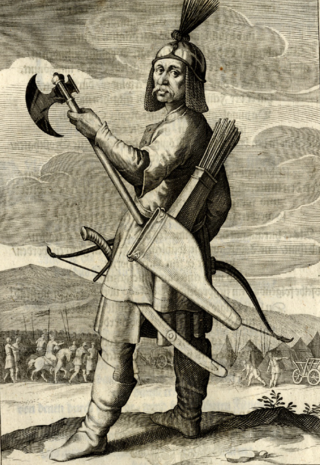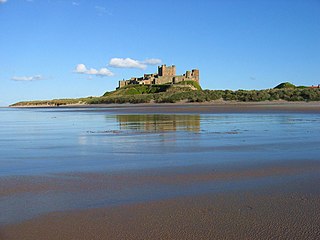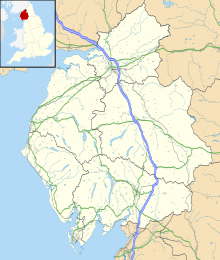
Year 954 (CMLIV) was a common year starting on Sunday of the Julian calendar.

Northumbria was an early medieval Anglo-Saxon kingdom in what is now Northern England and south-east Scotland.

Eadred was King of the English from 26 May 946 until his death in 955. He was the younger son of Edward the Elder and his third wife Eadgifu, and a grandson of Alfred the Great. His elder brother, Edmund, was killed trying to protect his seneschal from an attack by a violent thief. Edmund's two sons, Eadwig and Edgar, were then young children, so Eadred became king. He suffered from ill health in the last years of his life and he died at the age of a little over thirty, having never married. He was succeeded successively by his nephews, Eadwig and Edgar.

Eric Haraldsson, nicknamed Bloodaxe and Brother-Slayer, was a Norwegian king. He ruled as King of Norway from 932 to 934, and twice as King of Northumbria: from 947 to 948, and again from 952 to 954.

Amlaíb mac Sitric, commonly called Amlaíb Cuarán, was a 10th-century Norse-Gael who was King of Northumbria and Dublin. His byname, cuarán, is usually translated as "sandal". His name appears in a variety of anglicized forms, including Olaf Cuaran, Anlaf Sihtricson and Olaf Sihtricson, particularly in relation to his short-lived rule in York. He was the last of the Uí Ímair to play a major part in the politics of the British Isles.

Scandinavian York or Viking York is a term used by historians for what is now Yorkshire during the period of Scandinavian domination from late 9th century until it was annexed and integrated into England after the Norman Conquest; in particular, it is used to refer to York, the city controlled by these kings and earls. The Kingdom of Jórvíc was closely associated with the much longer-lived Kingdom of Dublin throughout this period.
Wulfstan was Archbishop of York between 931 and 952. He is often known as Wulfstan I, to separate him from Wulfstan II, Archbishop of York.
This timeline summarises significant events in the history of Northumbria and Northumberland.
Osulf or Oswulf was the son of Eadwulf IV, Earl of Bamburgh, and grandson of Uhtred the Bold, ruler of Bamburgh and ealdorman of Northumbria. Oswulf’s family ruled Bamburgh from 954 until 1041, though their independence may have been compromised after 1041 when Siward the Stout killed Eadwulf and gained hegemony over the north.
Eadwulf or Eadulf was ruler of Bamburgh in the early tenth century. A genealogy in the twelfth-century text De Northumbria post Britannos recording the ancestry of Waltheof Earl of Northampton, makes Eadwulf the son of Æthelthryth daughter of Ælla, King of Northumbria, but no source names Eadwulf's own father.
Ealdred was a ruler of Bamburgh, at least part of the former kingdom of Bernicia in northern Northumbria, in the early tenth century. He was the son of Eadwulf.
Uhtred of Bamburgh, was ruler of Bamburgh and from 1006 to 1016 the ealdorman of Northumbria. He was the son of Waltheof I, ruler of Bamburgh (Bebbanburg), whose family the Eadwulfings had ruled the surrounding region for over a century. Uhtred's death by assassination was described in De obsessione Dunelmi and has been interpreted as the beginning of a blood feud. Lest he be confused with Uhtred, the son of Eadwulf I of Bamburgh, he historically has been referred to as Uhtred the Bold.

Oswulf was ruler of Bamburgh and subsequently, according to later tradition, commander of all Northumbria under the lordship of King Eadred of England. He is sometimes called "earl" or "high reeve", though the precise title of the rulers of Bamburgh is unclear. By the twelfth century Oswulf was held responsible for the death of Northumbria's last Norse king, Eric of York, subsequently administering the Kingdom of York on behalf of Eadred.
Waltheof was high-reeve or ealdorman of Bamburgh. He was the son of Ealdred, and the grandson of Oswulf I and was father of Uhtred the Bold, Ealdorman of Northumbria.
Events from the 1060s in England.
Events from the 10th century in the Kingdom of England.

Viking activity in the British Isles occurred during the Early Middle Ages, the 8th to the 11th centuries CE, when Scandinavians travelled to the British Isles to raid, conquer, settle and trade. They are generally referred to as Vikings, but some scholars debate whether the term Viking represented all Scandinavian settlers or just those who used violence.
Eadwulf II, nicknamed Evil-child, was ruler of Bamburgh in the latter half of the tenth century. Although Eadwulf is sometimes described as the Earl of Northumbria, he ruled only a northern portion of Northumbria, a polity centred on Bamburgh that once stretched from the Firth of Forth to the River Tees.

Ragnall Guthfrithson was a Viking leader who ruled Viking Yorkshire in the 10th century. He was the son of Gofraid ua Ímair and great-grandson of Ímar, making him one of the Uí Ímair. He ruled Northumbria in 943 and 944, either with, or in opposition to, Olaf Cuaran. Ragnall and Olaf were driven out of Northumbria by the English in 944. His later life is unknown but it is possible he was the "king of the Danes" who is reported as being killed by the Saxons at York in 944 or 945.









